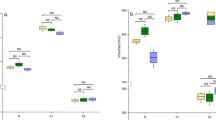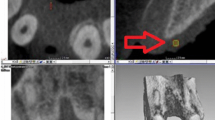Abstract
The aim of this study was to evaluate the accuracy and reproducibility of a morphological contour interpolation (MCI) based segmentation method for the volumetric measurement of bone grafts around implants. Three 3D-printed models (one with a cylinder and two with a geometrically-complex form) were fabricated to simulate implant placement with a simultaneous guided bone regeneration (GBR) procedure. All models were scanned using a cone beam computed tomography (CBCT) instrument with the same parameters. The true volumes of the bone grafts in the models were assessed using computer-aided calculation (controls). For the test measurements, both manual and MCI-based methods were used. A comparison between the measured and true volumes was performed to evaluate the accuracy. The coefficients of variation of repeated measurements were calculated to evaluate the reproducibility. In addition, the execution time was recorded and a comparison between the two methods was performed. The high accuracy of the MCI-based method was found with differences between the measured value and actual volume, which never exceeded 7.3%. Excellent reproducibility was shown, with coefficients of variation never exceeding 1.1%. A shorter execution time was observed for the MCI-based method than for the manual method. Within the confines of this study, the MCI-based method may be suitable for volumetric measurements of grafted bone around implants.
Similar content being viewed by others
References
HÄMMERLE C H F, JUNG R E. Bone augmentation by means of barrier membranes [J]. Periodontology 2000, 2003, 33(1): 36–53.
JUNG R E, HÄLG G A, THOMA D S, et al. A randomized, controlled clinical trial to evaluate a new membrane for guided bone regeneration around dental implants [J]. Clinical Oral Implants Research, 2009, 20(2): 162–168.
BRÜGGER O E, BORNSTEIN M M, KUCHLER U, et al. Implant therapy in a surgical specialty clinic: An analysis of patients, indications, surgical procedures, risk factors, and early failures [J]. The International Journal of Oral & Maxillofacial Implants, 2015, 30(1): 151–160.
WISMEIJER D, JODA T, FLÜGGE T, et al. Group 5 ITI consensus report: Digital technologies [J]. Clinical Oral Implants Research, 2018, 29(Sup 16): 436–442.
VERDUGO F, SIMONIAN K, SMITH MCDONALD R, et al. Quantitation of mandibular ramus volume as a source of bone grafting [J]. Clinical Implant Dentistry and Related Research, 2009, 11(Sup 1): e32–e37.
DASMAH A, THOR A, EKESTUBBE A, et al. Particulate vs. block bone grafts: Three-dimensional changes in graft volume after reconstruction of the atrophic maxilla, a 2-year radiographic follow-up [J]. Journal of Cranio-Maxillofacial Surgery, 2012, 40(8): 654–659.
BENIC G I, ELMASRY M, HÄMMERLE C H F. Novel digital imaging techniques to assess the outcome in oral rehabilitation with dental implants: A narrative review [J]. Clinical Oral Implants Research, 2015, 26(S11): 86–96.
KIRMEIER R, PAYER M, WEHRSCHUETZ M, et al. Evaluation of three-dimensional changes after sinus floor augmentation with different grafting materials [J]. Clinical Oral Implants Research, 2008, 19(4): 366–372.
KRENNMAIR G, KRAINHÖFNER M, MAIER H, et al. Computerized tomography-assisted calculation of sinus augmentation volume [J]. The International Journal of Oral & Maxillofacial Implants, 2006, 21(6): 907–913.
ALBU A B, BEUGELING T, LAURENDEAU D. A morphology-based approach for interslice interpolation of anatomical slices from volumetric images [J]. IEEE Transactions on Biomedical Engineering, 2008, 55(8): 2022–2038.
LI Y, QIAO S C, GUYX, et al. A novel semiautomatic segmentation protocol to evaluate guided bone regeneration outcomes: A pilot randomized, controlled clinical trial [J]. Clinical Oral Implants Research, 2019, 30(4): 344–352.
SANG Y H, HU H C, LU S H, et al. Accuracy assessment of three-dimensional surface reconstructions of in vivo teeth from cone-beam computed tomography [J]. Chinese Medical Journal, 2016, 129(12): 1464–1470.
XI T, SCHREURS R, HEERINK W J, et al. A novel region-growing based semi-automatic segmentation protocol for three-dimensional condylar reconstruction using cone beam computed tomography (CBCT) [J]. PLoS One, 2014, 9(11): e111126.
WAGNER M E H, GELLRICH N C, FRIESE K I, et al. Model-based segmentation in orbital volume measurement with cone beam computed tomography and evaluation against current concepts [J]. International Journal of Computer Assisted Radiology and Surgery, 2016, 11(1): 1–9.
PARSA A, IBRAHIM N, HASSAN B, et al. Assessment of metal artefact reduction around dental titanium implants in cone beam CT [J]. Dento Maxillo Facial Radiology, 2014, 43(7): 20140019.
KAMBUROGLU K, KOLSUZ E, MURAT S, et al. Assessment of buccal marginal alveolar peri-implant and periodontal defects using a cone beam CT system with and without the application of metal artefact reduction mode [J]. Dento Maxillo Facial Radiology, 2013, 42(8): 20130176.
PAUWELS R, STAMATAKIS H, BOSMANS H, et al. Quantification of metal artifacts on cone beam computed tomography images [J]. Clinical Oral Implants Research, 2011, 24(A100): 94–99.
Author information
Authors and Affiliations
Corresponding author
Additional information
Foundation item: the Project of Science and Technology Commission of Shanghai Municipality (No. 19411950100), the Multicenter Clinical Research Program of Shanghai Jiao Tong University School of Medicine (No. DLY201822), and the Fundamental Research Program Funding of Ninth People’s Hospital affiliated to Shanghai Jiao Tong University School of Medicine (No. JYZZ102)
Rights and permissions
About this article
Cite this article
Shi, J., Li, Y., Zhang, X. et al. Accuracy Assessment of a Novel Radiographic Method to Evaluate Guided Bone Regeneration Outcomes Using a 3D-Printed Model. J. Shanghai Jiaotong Univ. (Sci.) 26, 284–289 (2021). https://doi.org/10.1007/s12204-021-2294-4
Received:
Accepted:
Published:
Issue Date:
DOI: https://doi.org/10.1007/s12204-021-2294-4
Key words
- morphological contour interpolation (MCI)
- guided bone regeneration (GBR)
- cone beam computed tomography (CBCT)
- artefact
- implant




